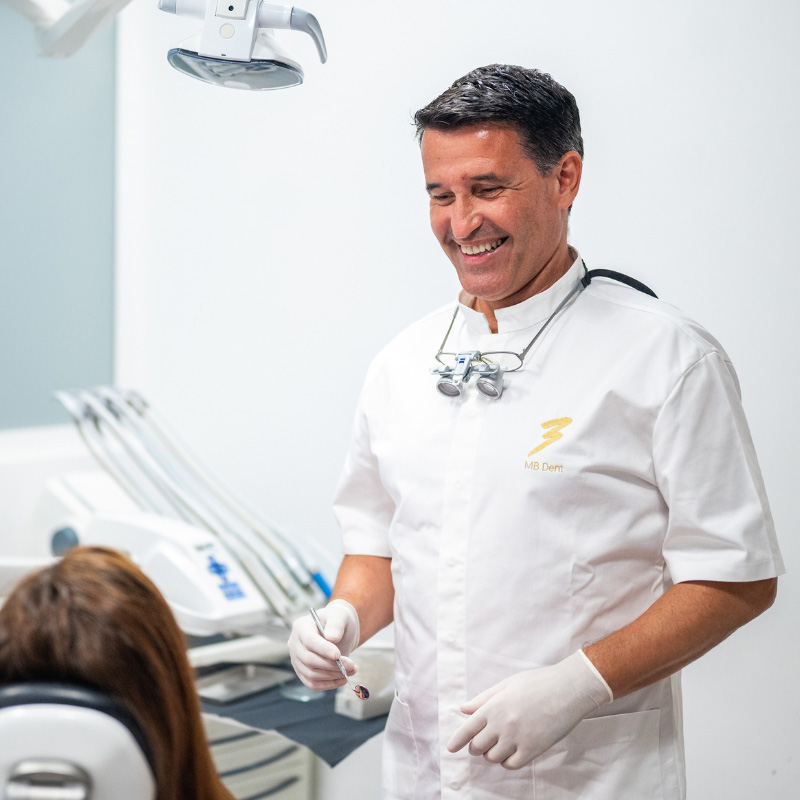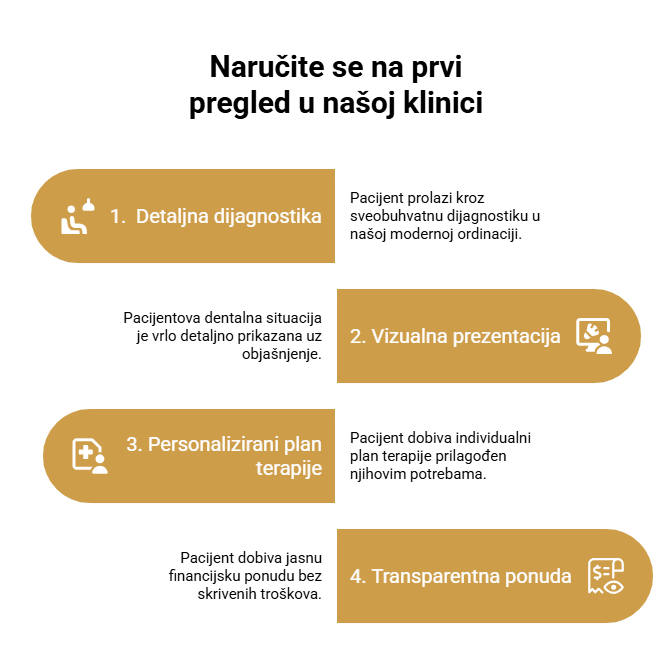Dental X-ray (orthopantomogram or orthopan, i.e., dental radiography) is a diagnostic method that uses a low dose of radiation to create detailed images of teeth, jaws, and surrounding structures. It aids in detecting caries, root infections, bone cysts, and growth abnormalities. During the imaging process, the patient wears a protective vest to shield against radiation. The frequency and need depend on diagnostic requirements and medical history.
A dental X-ray image assists dentists in many procedures to carry them out more accurately and precisely, and to better understand the patient’s situation.
What is a dental X-ray?
A dental X-ray, also known as a dental radiograph or orthopantomogram (OPG), is a diagnostic technique that uses X-rays to generate images of teeth, jaws, and surrounding structures.
When is a dental X-ray used?
This procedure enables dentists and orthodontists to gain a detailed insight into a patient’s oral health, discover hidden problems, and plan appropriate treatment. Dental X-rays help identify caries, tooth root infections, abnormalities in growth and position of teeth, presence of cysts, tumors, and other pathological conditions. This non-invasive process typically involves the patient standing or sitting while the X-ray tube circles the head, creating a series of images. It’s important to emphasize that a low dose of radiation is used to ensure patient safety.
Dental X-rays are extremely useful in numerous procedures, some of which are:
- Diagnosis and monitoring: Dental X-rays provide dentists with a detailed view of the internal structures of the oral cavity and jaw. This helps diagnose various conditions such as caries, tooth root infections, cysts, tumors, abnormalities in growth and position of teeth, and conditions of gums and bone.
- Treatment planning: Based on X-ray images, dentists can precisely plan treatments such as tooth extraction, root treatment, implant placement, orthodontic therapies, and other dental procedures.
- Monitoring tooth development: X-ray images allow monitoring of tooth growth and development in children and assessing the need for orthodontic treatments to ensure proper tooth alignment.
- Evaluating oral health: Dental X-rays assist in evaluating overall oral health, identifying potential problems, and intervening timely to prevent disease progression.
- Implant placement: X-ray images enable precise planning and placement of dental implants, which is crucial for successful integration.
- Prosthetics adjustment: In creating dental crowns, bridges, or dentures, X-ray images help in precise fitting and placement of prosthetic replacements.
What types of dental X-rays are there?
Orthopantomogram (2D imaging)
2D dental imaging, such as bitewing, periapical, occlusal, TMJ images, and others, provides dentists with an important tool for diagnosis, treatment planning, and oral health monitoring. 2D dental imaging can assist in:
- Caries diagnosis: “Bitewing” images allow for the detection of caries between teeth, in places that are hard to see with the naked eye. This helps dentists discover the early stages of caries and intervene before the problem worsens.
- Evaluating the condition of tooth roots: Periapical images offer a detailed view of tooth roots, aiding in diagnosing issues such as root infections, cysts, or other pathologies.
- Monitoring tooth development: 2D images facilitate monitoring of tooth growth and development in children and adolescents, identifying potential growth and positioning problems.
- Treatment planning: Dentists use 2D images to plan various treatments, including tooth extraction, implant placement, orthodontic therapies, and other dental procedures.
- Identifying pathologies: 2D images help detect the presence of cysts, tumors, or other pathological conditions in the oral cavity and jaw.
- Assessing overall oral health: Displaying the entire dental arch or facial profile helps dentists obtain a comprehensive overview of the condition of teeth, jaw, and gums.
- Monitoring treatment progress: 2D images enable tracking of how diseases or issues develop over time and how they respond to treatments.
Ultimately, 2D dental images are a key tool in diagnostics and treatment planning, enabling the provision of the best possible care for oral health.
CBCT imaging (3D imaging)
CBCT (Cone Beam Computed Tomography) dental imaging is a special type of X-ray that offers a three-dimensional view of teeth, jaws, and surrounding tissues. This technology provides a more detailed and precise examination of the oral cavity and maxillofacial area compared to traditional two-dimensional X-ray techniques. CBCT images are frequently used in dentistry and oral surgery for several reasons:
- Detailed anatomical view: CBCT provides three-dimensional images that offer a more detailed view of structures such as teeth, roots, bone, sinus cavities, and nerves.
- Implant planning: CBCT is often used for planning the placement of dental implants. It helps dentists precisely determine the optimal location for the implant, considering bone density and the position of important anatomical structures.
- Orthodontics: CBCT images are used for accurately assessing the position of teeth and jaws in orthodontic cases.
- Detecting pathologies: CBCT enables early detection of cysts, tumors, root infections, and other pathological conditions.
- Surgical planning: Before oral surgical procedures such as wisdom tooth extraction or jaw correction, CBCT helps surgeons precisely plan the operation.
- Monitoring treatment: CBCT images allow monitoring of changes in structures over time and evaluating the effectiveness of treatment.
CBCT (Cone Beam Computed Tomography) images have several advantages compared to traditional 2D dental X-ray images (orthopan):
- Three-dimensional view: CBCT provides three-dimensional images of teeth, jaws, and surrounding tissues. This allows for a more detailed view of anatomy, particularly useful in complex dental and maxillofacial cases.
- Precise planning: CBCT enables precise planning of dental treatments, such as implant placement, wisdom tooth extraction, orthodontic therapy, and oral surgical procedures. The three-dimensional view helps dentists choose the optimal technique and location for intervention.
- Pathology detection: CBCT images allow for early detection of cysts, tumors, root infections, and other pathological conditions. The three-dimensional view facilitates the identification and monitoring of these issues.
- Orthodontics: CBCT is used in orthodontics for accurately assessing the position of teeth and jaws. This aids orthodontists in planning and conducting treatments to correct irregularities with greater precision.
- Reduced radiation exposure: Although CBCT uses more radiation than 2D images, modern technology allows for reducing the radiation dose to the minimum necessary level, thus decreasing potential risk.
- Soft tissue visualization: CBCT enables the visualization of soft tissues such as muscles, blood vessels, and nerves. This is particularly useful in surgical and reconstructive cases.
- Faster procedure: CBCT imaging often requires less time to perform compared to the complex process of taking a series of 2D images.
Are there side effects of exposure to dental X-ray?
Exposure to dental X-ray typically involves a low dose of radiation, though it’s important to consider safety guidelines and the need to minimize exposure to ionizing radiation. In most cases, the risk of side effects from dental X-ray is very low, especially with adherence to appropriate protocols and rules.
- Low dose of radiation: X-ray images taken in dental offices usually use a low dose of radiation, reducing the potential risk of side effects.
- Patient protection: Patients are often provided with protective vests or cloths that cover the neck and body, reducing radiation exposure to other body parts.
- Pregnancy and children: Pregnant women and children are particularly sensitive to radiation. Dentists will avoid taking X-ray images in pregnant women whenever possible, and when necessary, use special precautions.
- Regular exposure: Regular dental X-rays over time can accumulate, so it’s important to adhere to the dentist’s recommendations and not take X-ray images without necessity.
- Safety guidelines: Dentists follow strict guidelines and protocols to minimize radiation exposure, considering the individual needs of each patient.
For any additional information, follow the blogs of the MB Dent clinic. If you would like more information from Dr. Matko Božić and his team, write to us at info@mbdent.com, WhatsApp 095 3634 337, or call us on the phone number 01 35 35 435 or mobile 095 3634 337.


